Minnesota goes by many names, including the Gopher State, the North Star State, and the Land of 10,000 Lakes. These names are rooted in the natural world and refer to the state’s natural riches. Minnesota is home to many plants and animals ranging from gophers to bison. However, Minnesota is not just the land of 10,000 lakes or giant mammals, as it’s also home to many species of spiders. From orb weavers to wolf spiders, you can find many spiders in Minnesota. Here is a list of 10 spiders in Minnesota that you may encounter during your next outing around the state.

Read on to learn more about these fascinating spiders, their sizes, their homes, and their prey!
#10: Striped Fishing Spider
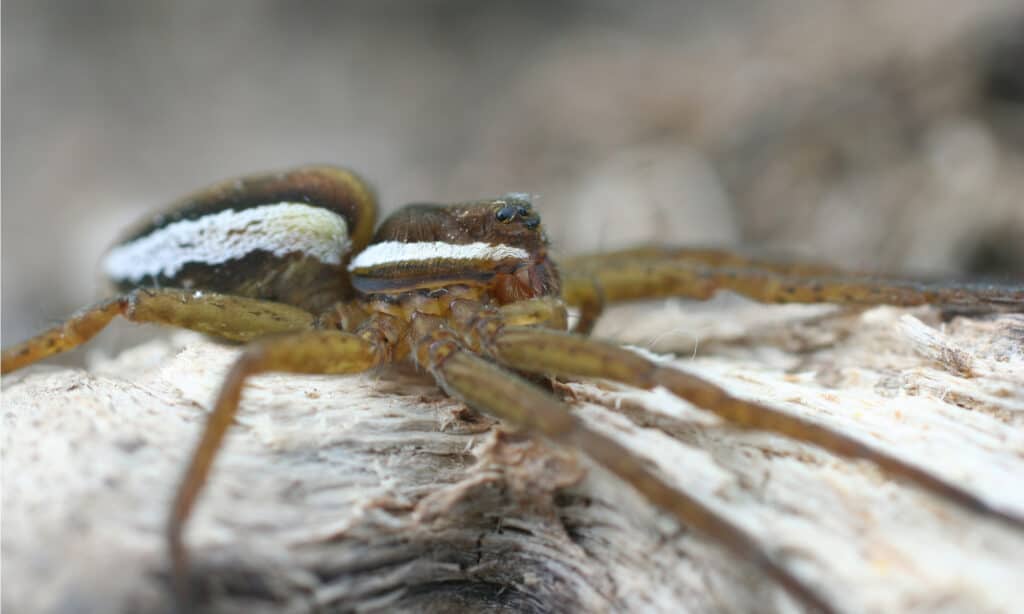
The striped fishing spider tends to prefer hunting near fast-flowering streams.
©Oleg Nikonov/Shutterstock.com
Dolomedes scriptus, or the striped fishing spider, is a member of the nursery web spider family Pisauridae. Its range extends throughout much of the United States and Canada. If you’re looking for these spiders in Minnesota, you’ll likely encounter them near fast-flowing streams, lakes, or ponds.
Adult females measure up to 2.5 centimeters long and sport a leg span of up to 6 centimeters. They appear predominantly light brown but may also look tan or greyish. Generally, they feature thin white or tan stripes down each side and characteristic W-shaped abdominal markings.
Like other fishing spiders, striped fishing spiders do not build webs to catch prey. Instead, they hunt by using their long legs to snatch insects and small fish from the water. They can also run across the water’s surface and dive into the water for short distances.
#9: Cat-Faced Spider
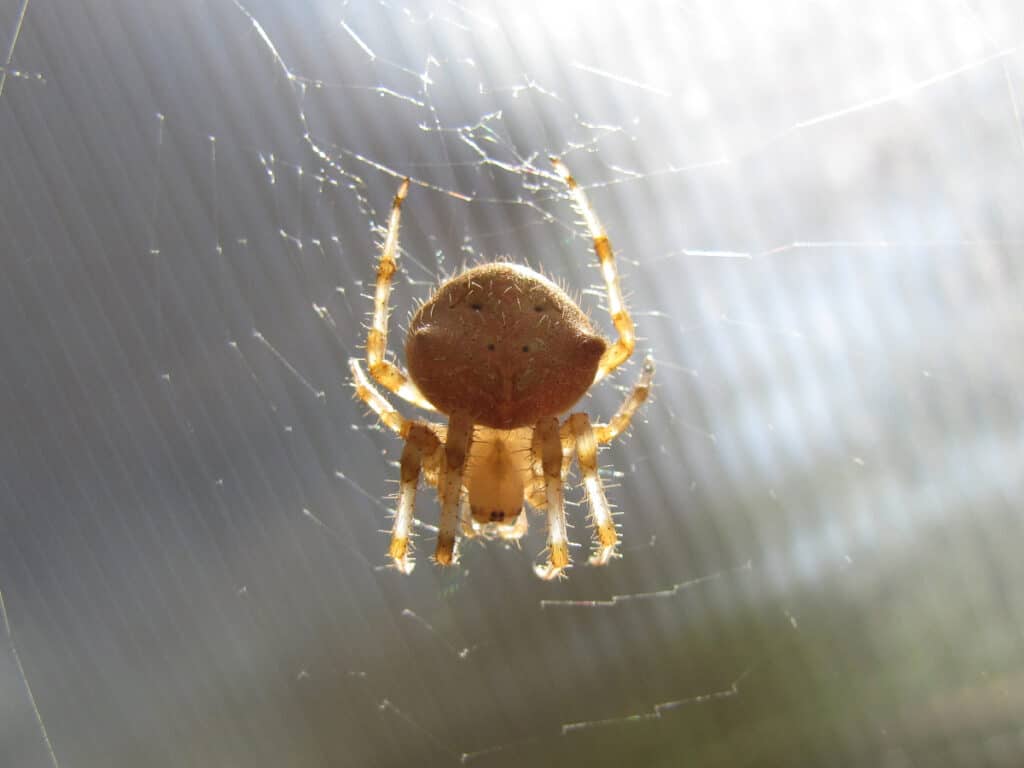
The cat-faced spider has an abdomen with large bumps that look like a cat’s face.
©iStock.com/TaosAnne
Also known as the jewel spider, the cat-faced spider (Araneus gemmoides) belongs to the orb-weaver family Araneidae. You can find this curiously-shaped spider in Minnesota and throughout much of the USA and Canada.
Adult females measure from 13 to 25 millimeters long, while males measure 5 to 8 millimeters long. Their bodies range in appearance from light yellow to chestnut brown, while they sport light and dark brown bands on their legs. They get their name from their abdomens, which feature two horn-shaped growths and markings that marginally look like the face of a cat.
You can usually find the webs of cat-faced spiders in areas with plenty of sunlight, such as walls along buildings, overhangs, and around woodpiles. Many people consider them beneficial because they prey on common pests. Although their bite is venomous, its low level of toxicity poses no threat to humans.
#8: Ground Wolf Spider
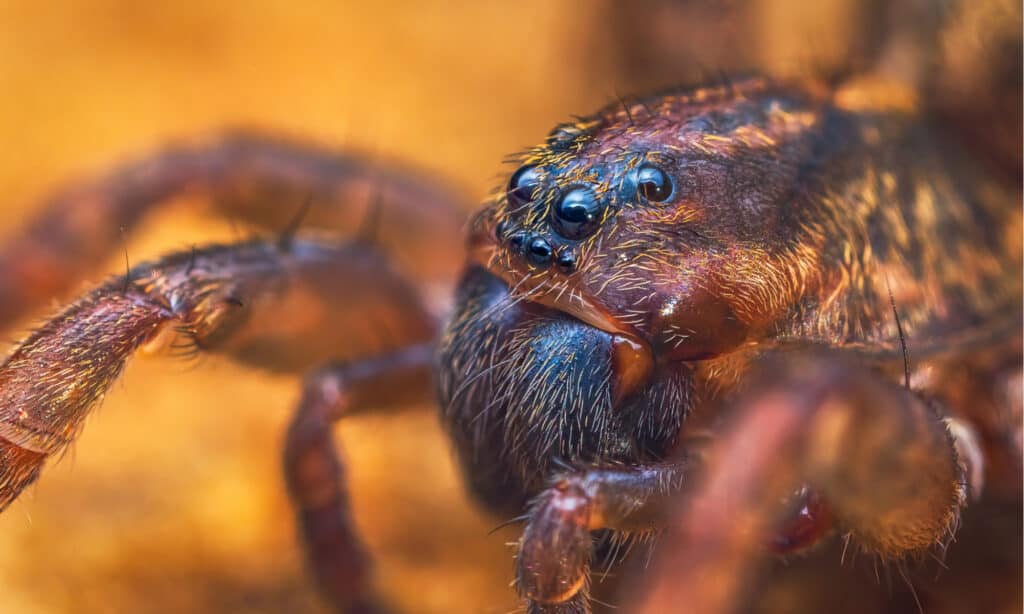
The ground wolf spider uses its strong jaws and legs to capture prey.
©Lukas Jonaitis/Shutterstock.com
The ground wolf spider, Trochosa terricola, belongs to the wolf spider family Lycosidae. While commonly found in Europe, this large species also range throughout the northern half of the United States and southern Canada.
Female ground wolf spiders measure between 7 and 14 millimeters long, and males measure 7 to 9 millimeters long. Females possess a reddish-brown abdomen while the males feature dark front legs. They sport characteristic short lines on the carapace and a light cardiac mark on the abdomen.
You will most likely encounter ground wolf spiders underneath leaf litter or rocks in woodlands or grasslands. Like other wolf spiders, they rely on their strong legs and jaws to immobilize their prey. They typically hunt at night, so bites are rare and not medically significant.
#7: Northern Black Widow
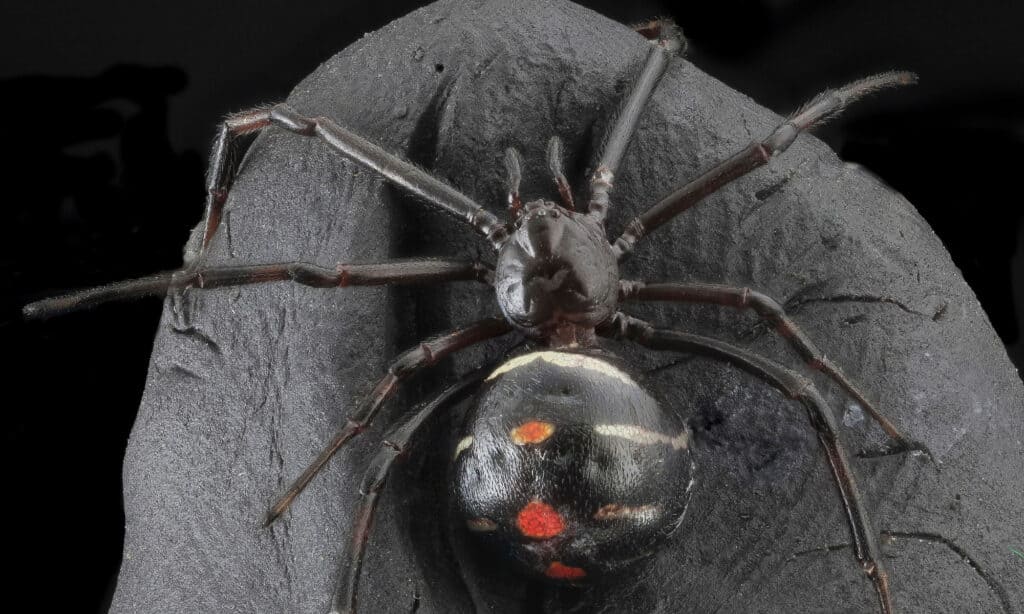
Unlike other black widows, northern black widows have a broken hourglass-shaped marking on their abdomens.
©Porco_Rosso/Shutterstock.com
The northern black widow, or simply northern widow, Latrodectus variolus, is one of the most venomous spiders in Minnesota. A member of the cobweb spider family Theridiidae, it ranges throughout the eastern and northern United States as well as southern Canada.
Adult females measure between 9 and 11 millimeters long, while males measure 4 to 5 millimeters long. They appear almost entirely black aside from a small, red hourglass-shaped marking on the abdomen. Unlike other black widows, which tend to have an intact hourglass marking, the hourglass marking on a northern black widow typically appears broken.
The bite of a northern black widow can cause the illness known as latrodectism. Because of its potent toxins, it is one of the few medically significant spiders in North America. Common symptoms of bites include pain, vomiting, sweating, and muscle rigidity. While death is possible, most bites are not life-threatening.
#6: Marpissa grata
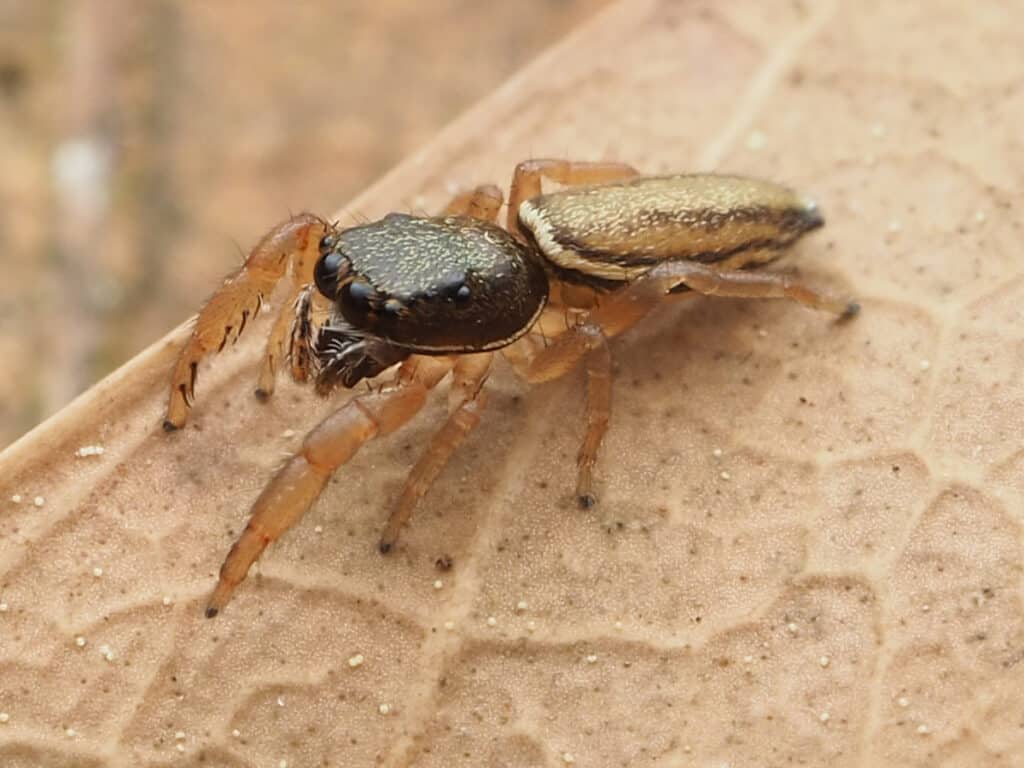
Marpissa gratta is endemic to the Great Lakes region of the United States.
©Zygy / Creative Commons – License
Marpissa grata is a jumping spider in the family Salticidae. It is endemic to the Great Lakes region. You can find these spiders in Minnesota as well as Michigan. Like some other lesser-known species, it is referred to only by its scientific name.
Most adult specimens measure around 7 millimeters long. Like other members of the genus Marpissa, these spiders tended to have thin abdomens. The abdomen tends to appear light brown or tan and may feature dark stripes. Meanwhile, the cephalothorax generally appears darker.
Marpissa grata spiders do not build webs to catch prey. Instead, they rely on their keen eyesight and jumping ability to catch insects. Due to their small size, their bite is not medically significant.
#5: Black and Yellow Garden Spider
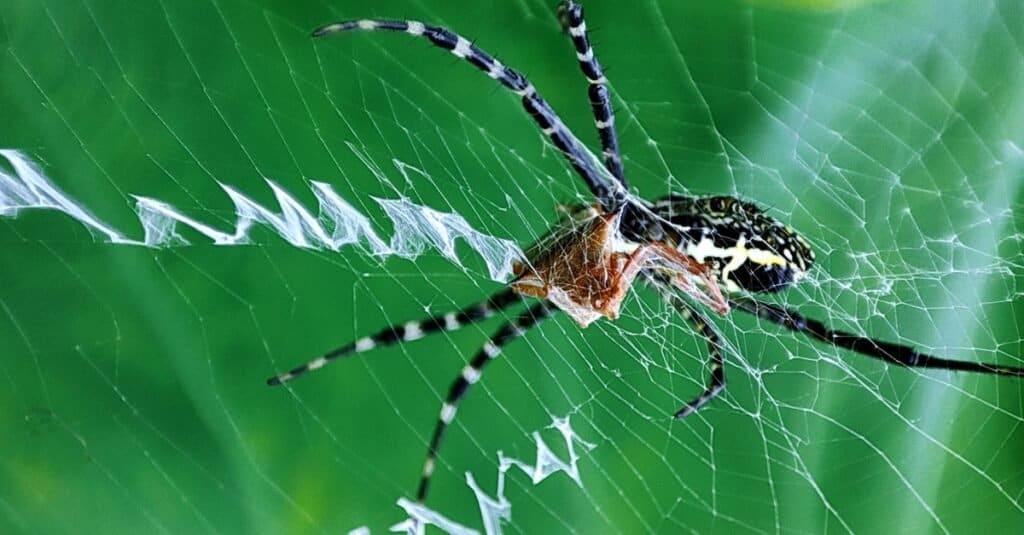
Black and yellow garden spiders spin zigzagging webs.
©iStock.com/Utpal Biswas
The black and yellow garden spider, Argiope aurantia, is the second member of the family Araneidae to make our list of spiders in Minnesota. It is one of the most widely distributed orb weavers in North America. Other common names for this garden-dwelling orb-weaver include the yellow garden spider, Steeler spider, or McKinley spider.
Adult females typically measure from 19 to 28 millimeters long, and males measure 5 to 9 millimeters long. They feature characteristic black, yellow, and silver markings on their abdomens, hence their name.
Black and yellow garden spiders construct large circular webs in fields or under the eaves of houses. They weave zigzag X and Z-shaped patterns into their webs, so some refer to them as writing spiders or zigzag spiders. After mating, the females often cannibalize the males.
#4. Giant Lichen Orb Weaver
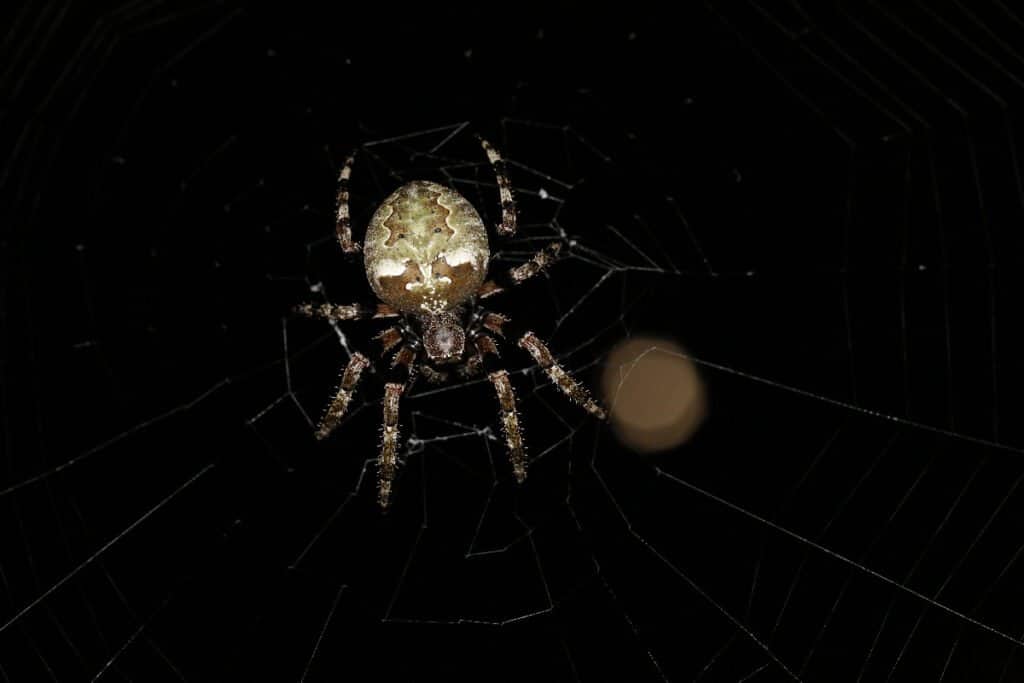
The giant lichen orb weaver creates webs nearly 8 feet wide.
©Cathleen Wake Gorbatenko/Shutterstock.com
The giant lichen orb weaver, Araneus bicentenarius, also belongs to the orb-weaver family Araneidae. You can find these giant orb weavers in Minnesota as well as throughout the central and eastern United States and parts of Canada.
Adult giant lichen orb weavers can measure up to 24 millimeters long, with males measuring smaller than females. They sport orange and black bands on their legs, while their abdomens look greyish-green and feature black and white markings. People sometimes mistake them for European garden spiders, but they lack the latter’s cross-shaped markings.
Giant lichen orb weavers get their name from both their size and their huge webs, which can reach nearly 8 feet wide. They hide in the corners of their webs during the day and emerge at night to catch prey. Although they are quite large, their bite is not medically significant and usually causes only some pain and redness.
#3. Slender Sea Crab Spider
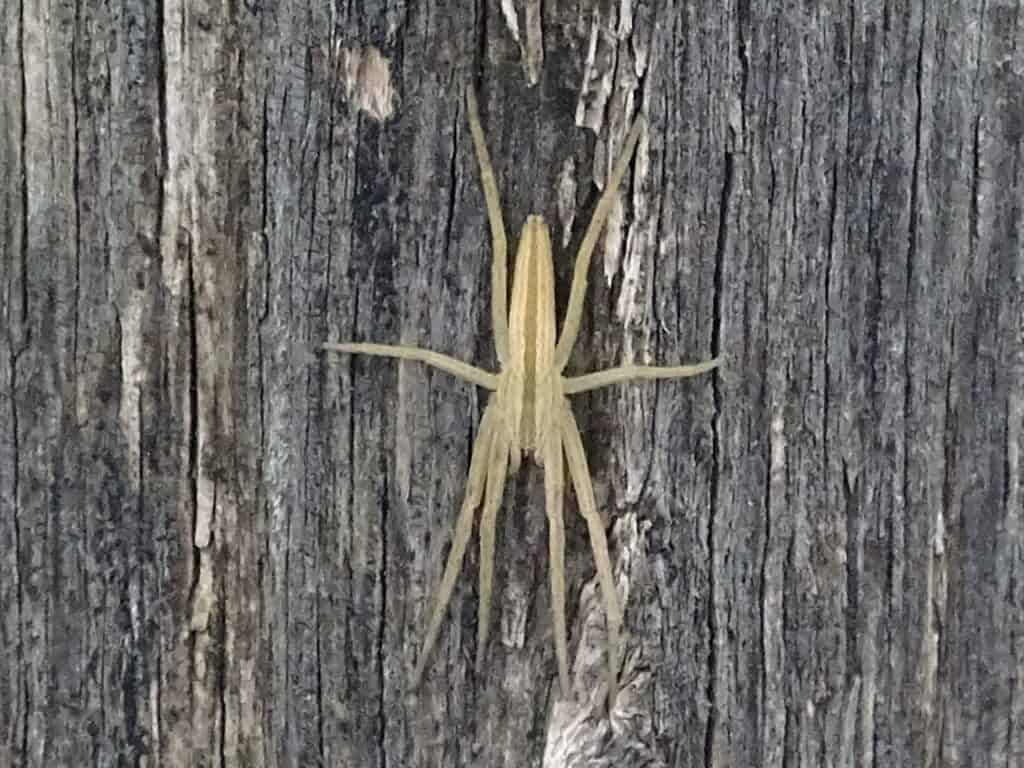
Tibellus maritimus uses its quick speed to chase down prey.
©Mosbo6 / Creative Commons – License
In English, Tibellus maritimus, translates roughly to “slender crab spider of the sea.” That said, it normally only goes by its scientific name. A member of the running crab spider family Philodromidae, you can find these curious crab spiders in Minnesota as well throughout North America, Europe, and Central Asia.
Adult females measure between 8 and 10 millimeters long, while males measure from 7 to 8 millimeters long. They possess distinctively elongated, slender bodies and long legs. Their bodies appear mostly light tan except for the abdomen, which may appear slightly darker. You can distinguish it from other members of its genus because it lacks dark spots on the underside of its abdomen.
Like other running crab spiders, Tibellus maritimus can run quite quickly. They often ambush insects while lying in wait on grasses or plant stems. Due to their small size, their bite is not medically significant.
#2: Northern Cupboard Spider
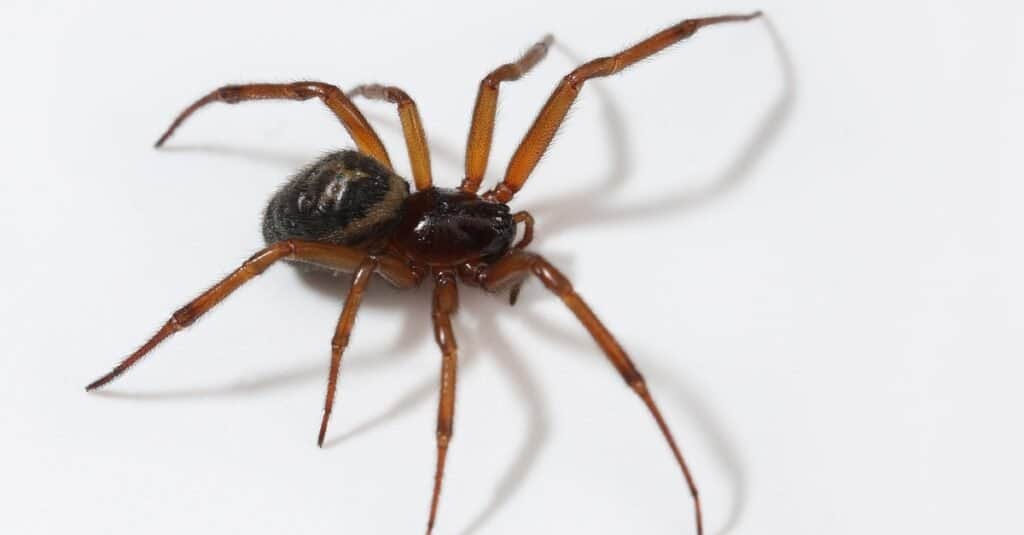
False widow spiders construct irregularly shaped webs.
©JASON STEEL/Shutterstock.com
The northern cupboard spider, Steatoda borealis, also goes by the name the boreal combfoot spider. It is a member of the cobweb or combfoot spider family Theridiidae. You can find these spiders in Minnesota as well as throughout the northern United States and Canada.
Adult specimens measure around 7 millimeters long, with males measuring smaller than females. They generally appear glossy dark brown or black and sport a characteristic T-shaped marking near the front of their bodies. They also go by the name false widows because people often confuse them with black widows.
Like other cobweb spiders, northern cupboard spiders construct irregularly-shaped webs that they use to capture their prey. To make up for their poor eyesight, they can detect tiny vibrations that allow them to tell when prey stumbles into their webs. While their bite can cause some pain, redness, and swelling, it poses little threat to humans.
#1. Barn Funnel Weaver
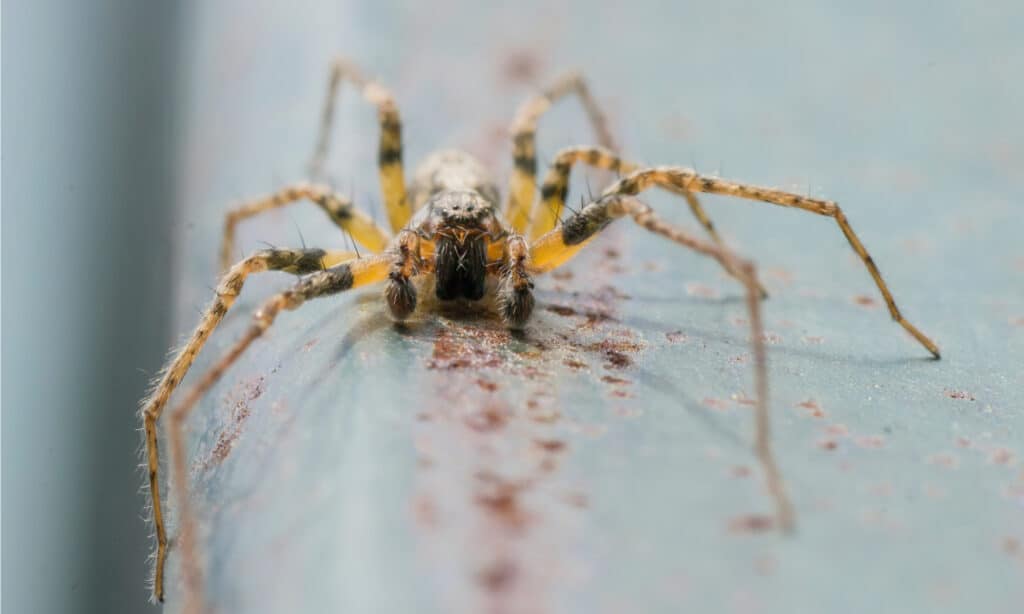
The barn funnel weaver spins a funnel-shaped web that it uses to capture prey.
©Korovko Gleb/Shutterstock.com
Tegenaria domestica, or the barn funnel weaver, also goes by the name the domestic house spider, particularly in Europe. It belongs to the funnel-web spider family Agelenidae. It is a cosmopolitan species that ranges throughout North America, Europe, North Africa, and Central Asia.
Adult females measure from 7 to 11 millimeters long, while males measure 6 to 9 millimeters long. Their bodies appear relatively long, and their abdomens look relatively straight instead of bulbous like some spiders. In terms of color, they look predominantly brown. That said, their abdomens appear gray-brown aside from a dark stripe in the center.
As their name implies, barn funnel weavers build funnel-shaped webs that they use to capture prey. They rarely act aggressively toward humans and usually flee when exposed to bright lights. Unlike their more dangerous funnel-weaving cousins, their bite is not considered medically significant.
Summary of 10 Spiders in Minnesota
| Rank | Species | Location | Key Features |
|---|---|---|---|
| 10 | Striped Fishing Spider | Throughout much of the United States and Canada. | Grayish-brown bodies and occasionally a white or tan stripe along each side W-shaped marks on the abdomen |
| 9 | Cat-Faced Spider | Throughout much of the United States and Canada. | Two horn-shaped growths and markings which resemble a cat’s face on the abdomen |
| 8 | Ground Wolf Spider | Throughout the northern half of the United States, Europe, and southern Canada | Reddish-brown carapace in femalesDark forelegs in males |
| 7 | Northern Black Widow | Throughout the eastern and northern United States and southern Canada. | Red hourglass marking on a black abdomen |
| 6 | Marpissa Grata | The United States and Canada | Large dark carapaced head Oval abdomen fringed with a pale silver band edged with black |
| 5 | Black and Yellow Garden Spider | Widely distributed in North America | An oval abdomen with yellow patterns, against black tapering toward the rear Long legs banded in black and yellow |
| 4 | Giant Lichen Orb Weaver | Throughout the central and eastern United States and parts of Canada. | Round, greenish abdomenLegs covered in green and brown bands |
| 3 | Slender Sea Crab Spider | North America, Europe, and Central Asia. | Translucent oval abdomen with a dark band through the center |
| 2 | Northern Cupboard Spider | Throughout the northern United States and Canada | Gleaming brown head, fuzz-covered abdomen |
| 1 | Barn Funnel Weaver | Throughout North America, Europe, North Africa, and Central Asia. | Gray-brown abdomen with a dark stripe running through its center |
The photo featured at the top of this post is © Lukas Jonaitis/Shutterstock.com
Thank you for reading! Have some feedback for us? Contact the AZ Animals editorial team.






